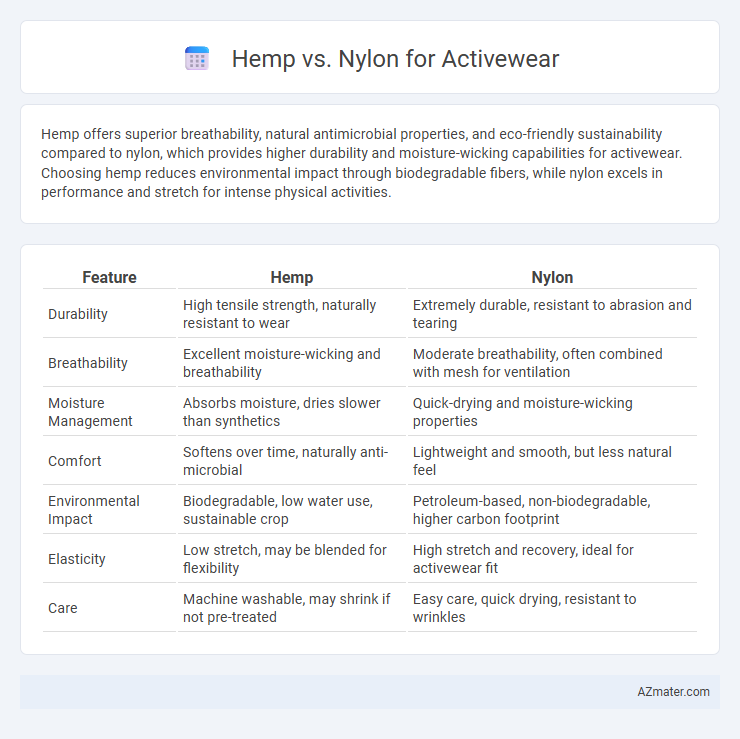Hemp offers superior breathability, natural antimicrobial properties, and eco-friendly sustainability compared to nylon, which provides higher durability and moisture-wicking capabilities for activewear. Choosing hemp reduces environmental impact through biodegradable fibers, while nylon excels in performance and stretch for intense physical activities.
Table of Comparison
| Feature | Hemp | Nylon |
|---|---|---|
| Durability | High tensile strength, naturally resistant to wear | Extremely durable, resistant to abrasion and tearing |
| Breathability | Excellent moisture-wicking and breathability | Moderate breathability, often combined with mesh for ventilation |
| Moisture Management | Absorbs moisture, dries slower than synthetics | Quick-drying and moisture-wicking properties |
| Comfort | Softens over time, naturally anti-microbial | Lightweight and smooth, but less natural feel |
| Environmental Impact | Biodegradable, low water use, sustainable crop | Petroleum-based, non-biodegradable, higher carbon footprint |
| Elasticity | Low stretch, may be blended for flexibility | High stretch and recovery, ideal for activewear fit |
| Care | Machine washable, may shrink if not pre-treated | Easy care, quick drying, resistant to wrinkles |
Introduction: Hemp vs Nylon in Modern Activewear
Hemp and nylon are two popular materials in modern activewear, each offering distinct benefits for performance and sustainability. Hemp is valued for its natural breathability, durability, and eco-friendly properties, making it ideal for environmentally conscious athletes. Nylon, a synthetic fiber, excels in moisture-wicking, stretchability, and lightweight comfort, enhancing performance during high-intensity activities.
Material Overview: Properties of Hemp and Nylon
Hemp fibers are naturally durable, breathable, and moisture-wicking, offering excellent UV protection and antimicrobial properties that make them ideal for sustainable activewear. Nylon, a synthetic polymer, provides superior elasticity, abrasion resistance, and quick-drying capabilities, enhancing performance in high-impact activities. While hemp excels in environmental benefits and comfort, nylon outperforms in stretch and durability under intense physical conditions.
Sustainability: Environmental Impact Comparison
Hemp activewear offers significant environmental advantages over nylon, as hemp is a biodegradable, renewable resource that requires minimal water, pesticides, and synthetic fertilizers during cultivation. Nylon production relies heavily on petrochemicals derived from fossil fuels, resulting in a high carbon footprint and substantial greenhouse gas emissions. Choosing hemp reduces reliance on non-renewable resources and minimizes microplastic pollution associated with nylon fabrics in the activewear industry.
Moisture-Wicking and Breathability
Hemp fabric outperforms nylon in moisture-wicking due to its natural fiber structure that efficiently absorbs and releases sweat, keeping the skin dry during intense activities. Hemp's superior breathability allows for better air circulation, reducing overheating and promoting comfort in activewear. Nylon, while lightweight and durable, tends to retain moisture longer and offers less ventilation compared to hemp's eco-friendly and high-performance properties.
Durability and Longevity
Hemp fibers exhibit exceptional durability and natural resistance to wear, making them ideal for long-lasting activewear that withstands frequent washing and intense physical activity. Nylon offers high tensile strength and excellent abrasion resistance, often surpassing hemp in elasticity and moisture-wicking properties. Combining hemp's eco-friendly robustness with nylon's stretch and resilience enhances overall durability and longevity for performance apparel.
Comfort and Skin-Friendliness
Hemp fibers offer superior breathability and natural moisture-wicking properties, making them highly comfortable and gentle on sensitive skin compared to nylon. Nylon, while durable and stretchy, can trap heat and cause irritation or sweating during intense physical activity. Choosing hemp activewear enhances comfort and skin-friendliness through its hypoallergenic and antimicrobial characteristics, promoting a cooler and irritation-free experience.
Odor Resistance and Antimicrobial Qualities
Hemp fibers naturally exhibit excellent odor resistance and antimicrobial qualities due to their ability to inhibit the growth of bacteria and fungi, making them ideal for activewear that requires prolonged wear without developing unpleasant smells. Nylon, while durable and moisture-wicking, lacks inherent antimicrobial properties and often requires chemical treatments to enhance odor control, which can diminish over time with washing. Choosing hemp-based activewear supports better hygiene and sustainability through its natural resistance to odor-causing microbes, reducing the need for frequent laundering and synthetic additives.
Style and Versatility in Activewear Design
Hemp fabric offers a natural, textured appearance that adds a distinctive, eco-friendly style to activewear, appealing to consumers seeking sustainable fashion. Nylon, known for its smooth finish and vibrant color retention, provides greater versatility in design options, enabling streamlined, high-performance activewear with diverse patterns and finishes. Combining hemp's breathable durability with nylon's stretch and resilience enhances both aesthetic appeal and functional flexibility in modern activewear collections.
Cost Comparison: Hemp vs Nylon Apparel
Hemp activewear typically costs more upfront due to sustainable cultivation and eco-friendly processing methods, while nylon apparel offers a lower price point driven by mass production and synthetic materials. Over time, hemp garments may provide better value because of their durability and natural biodegradability, reducing replacement frequency and environmental impact. Nylon, although cheaper initially, often requires more frequent replacement due to lower breathability and abrasion resistance in high-performance settings.
Conclusion: Choosing the Best Fabric for Activewear
Hemp offers superior breathability, moisture-wicking properties, and natural antimicrobial benefits, making it ideal for sustainable and comfortable activewear. Nylon excels in durability, elasticity, and quick-drying performance, suited for high-intensity workouts requiring stretch and resilience. Selecting between hemp and nylon depends on balancing eco-friendliness with technical performance tailored to specific athletic needs.

Infographic: Hemp vs Nylon for Activewear
 azmater.com
azmater.com